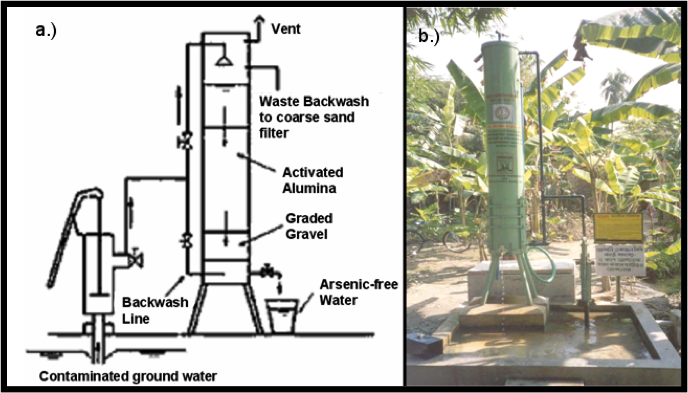Arsenic Crisis In Indian Subcontinent: An Indigenous Solution
Arup K. SenGupta Department of Civil and Environmental Engineering, LEHIGH UNIVERSITY, Bethlehem, PA 18015, U.S.A.
Far more catastrophic than Bhopal and Chernobyl disasters is the arsenic inflicted crisis affecting millions of people in Bangladesh and in the Eastern parts of India. Contrary to Bhopal and Chernobyl events, however, arsenic crisis in the Indian subcontinent is more of a natural calamity. Groundwater which is the primary source of drinking water for millions living in rural and often poorly accessible areas, is contaminated with high levels of arsenic (over 100 parts per billion) through geochemical soil leaching. Unacceptably high arsenic concentration in groundwater is not something unique and has been reported in many other countries including USA. But never have the magnitude of crisis and the resulting tragedy been comparable to what are being witnessed in the Indian subcontinent.
The pictures show signs of skin lesions and other symptoms of arsenic poisoning resulting from drinking of arsenic contaminated water in villages of West Bengal, India.

In many areas, villagers do not have access to any secondary source of drinking water. Simple-to-operate treatment units at the existing well heads are practically the only solutions to ensure supply of arsenic free water on a daily basis. To this effect, the Civil Engineering department at the Bengal Engineering College, Howrah, West Bengal installed eight well head arsenic removal units in the districts of 24 Parganas and Nadia. The project was financed primarily through a grant obtained from Water For People (WEP), an affiliation of American Water Works Association (AWWA) located in Denver, Colorado. The figure below shows the schematic of a typical well-head arsenic removal unit. It is important to note that every component of these arsenic- removal units was procured and fabricated locally.
The following are some salient features of these units:
Well-Head Arsenic Removal Unit Schematic Diagram (a) Actual Installation (b)

- The entire operation is manual and does not require any electricity. The arsenic removal columns are installed at the existing tube wells with hand pumps.
- Activated alumina(AA) which selectively removes dissolved arsenic from groundwater without changing its composition is the primary adsorbent used in the column and readily available from a company in Durgapur, West Bengal.
- Some of the latest installations contain hybrid polymeric sorbent known as HAIX developed at Lehigh University, that selectively remove arsenic from background of other species of ground water
- Both AA and HAIX are amenable to efficient regeneration and can be used for 10 to 15 cycles
- The unit does not warrant any chemical addition or sophisticated control. All one needs to do are open a valve, operate the hand pump and then collect essentially arsenic free water in a container. Regardless of the extent of contamination in well water, the arsenic concentration in treated water will consistently be less than twenty parts per billion - the standard set by World Health Organisation for drinking water.
- The regeneration of the unit with caustic soda is required about once in a year. During regeneration, the entire amount of arsenic removed can be easily converted into less than two liters of sludge and retained at the top of a well aerated coarse sand filter. To put a quantitative perspective, a 4ft by 3ft by 6ft pit is large enough to store the entire amount of arsenic laden sludge for over 10 years. The method of disposal/ containment of arsenic laden waste in a well ventilated pit is scientifically sound without further possibility of arsenic leaching.
- Upon installation of an arsenic removal unit, a villager’s committee is set up to maintain daily backwashing operation and periodical monitoring of arsenic concentrations. Economic sustenance comes through realization of water tariff per month which is about Rs.15 (less than 50 US Cents) per family.
In recognition of contributions made by late Prof. Amal Dutta of the Bengal Engineering college, the well head treatment systems using activated alumina have been named "AMAL ARSENIC REMOVAL UNITS".
Sponsor:
Water For People (WFP) (An affiliation of American Water Works Association) Denver, Colorado, U.S.A.
Project Engineers:
Ranjan Biswas
Department of Civil Engineering
Bengal Engineering and Science University, Howrah, West Bengal, India
Technical Advisors:
Arun Deb
Roy F. Weston Co.
Pennsylvania, U.S.A.
Department of Civil and Environmental Engineering, Lehigh University,
Bethlehem, Pennsylvania, U.S.A.
